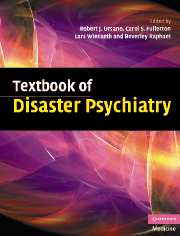Book contents
- Frontmatter
- Contents
- List of contributors
- Preface
- Part I Introduction
- Part II Foundations of disaster psychiatry
- Part III Clinical care and interventions
- 6 Early intervention for trauma-related problems following mass trauma
- 7 Acute stress disorder and post-traumatic stress disorder in the disaster environment
- 8 Assessment and management of medical-surgical disaster casualties
- 9 Interventions for acutely injured survivors of individual and mass trauma
- 10 Nongovernmental organizations and the role of the mental health professional
- Part IV Special topics
- Part V Public health and disaster psychiatry
- Index
- References
8 - Assessment and management of medical-surgical disaster casualties
from Part III - Clinical care and interventions
Published online by Cambridge University Press: 09 August 2009
- Frontmatter
- Contents
- List of contributors
- Preface
- Part I Introduction
- Part II Foundations of disaster psychiatry
- Part III Clinical care and interventions
- 6 Early intervention for trauma-related problems following mass trauma
- 7 Acute stress disorder and post-traumatic stress disorder in the disaster environment
- 8 Assessment and management of medical-surgical disaster casualties
- 9 Interventions for acutely injured survivors of individual and mass trauma
- 10 Nongovernmental organizations and the role of the mental health professional
- Part IV Special topics
- Part V Public health and disaster psychiatry
- Index
- References
Summary
Introduction
Having medical or surgical injuries or conditions following a disaster or terrorist attack increases the likelihood a psychiatric condition is also present. Fear of exposure to toxic agents can drive many times more patients to medical facilities than actual terrorism-related toxic exposures. Existing postdisaster and post-terrorism algorithms consider predominantly medical and surgical triage and patient management. There are few specific empirical data about the potential effectiveness of neuropsychiatric triage and treatment integrated into the medical-surgical triage and management processes (Burkle, 1991). This is unfortunate, since there are lines of evidence to suggest that early identification of psychiatric casualties can help decrease medical-surgical treatment burden, decrease inappropriate treatments of patients, and possibly decrease long-term psychological sequelae in some patients (Rundell, 2000). Physicians and mental health professionals involved in disaster/terrorism response planning should understand the importance of considering behavioral symptoms within the context of concurrent medical-surgical assessment and treatment (Rundell, 2003). Effective medical-psychiatric differential diagnosis and adequate attention to public risk communication lessen the risk of medical or psychiatric misdiagnoses, and decrease the odds that healthcare systems may be overwhelmed (Rundell & Christopher, 2004). This chapter will identify how postdisaster patient triage and management can incorporate behavioral/psychiatric assessment and treatment, merging behavioral and medical approaches in the differential diagnosis and early management of common psychiatric syndromes among medical-surgical disaster or terrorism casualties.
Keywords
- Type
- Chapter
- Information
- Textbook of Disaster Psychiatry , pp. 164 - 189Publisher: Cambridge University PressPrint publication year: 2007
References
- 6
- Cited by



